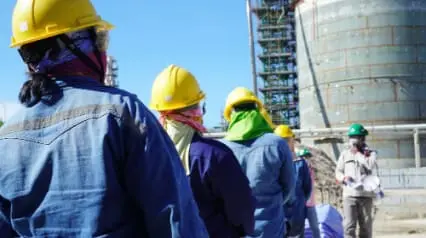What is Safety Training?
Safety training is the process of educating individuals about potential hazards, safe practices, emergency procedures, and guidelines for maintaining a safe working environment. It equips individuals with the necessary knowledge and skills to identify, react, and mitigate risks.
Importance and Benefits
Safety training is not entirely just for legal requirements but also a moral obligation for organizations. It ensures the protection of employees, visitors, and assets. Having a proper safety training procedure reduces workplace accidents, increases employee morale, protects your equipment, and complies with safety regulations.
Types of Safety Training
Safety training programs can be classified into two types, depending on the scope and content of the material. These are as follows:
General Safety Training
General safety training provides a broad understanding of safety principles applicable across various industries. It includes topics that are essential to all workers like the following:
- Fire safety,
- First aid
- Emergency evacuation procedures
- Personal Protective Equipment (PPE) safety
- Electrical safety
- Hazard reporting measures
Industry-Specific Safety Training
Different industries have unique risks and requirements. Industry-specific safety training tailors the content to address the particular hazards and regulations within a specific field. After all, safety training for construction teams will have a distinct scope compared to those for retail staff members, as they face different risks.
Overview of Safety Regulations for Training
Safety regulations are laws and guidelines established by government agencies to ensure the well-being of employees. These regulations vary by country and are often specific to particular industries.
Compliance with safety regulations is a continuous process that involves regular audits, assessments, and improvements. Organizations must stay up-to-date with changes in these laws and adjust their practices accordingly.
Industry-Specific Regulations
Different industries may have additional safety training requirements that go beyond general regulations. These regulations are tailored to the unique risks associated with the industry.
Make sure to consult with your local, national, and regional authorities on the safety training laws and regulations applicable to your field. To make this step easier, here’s a quick run-through of the major safety agencies around the world:
- United States – Occupational Safety and Health Administration (OSHA)
- United Kingdom – Health and Safety Executive (HSE)
- Canada – Canadian Center for Occupational Health and Safety (CCOHS)
- European Union – European Agency for Safety and Health at Work (EU-OSH)
- Australia – Safe Work Australia
International Standards
International safety standards provide a consistent framework for organizations operating across borders. Many organizations adhere to international safety standards, such as ISO 45001, to ensure a global approach to safety.
Compliance ensures a unified approach to safety worldwide. In addition, it can enhance an organization’s reputation and global competitiveness.
How can I stay up-to-date with the latest safety regulations and best practices?
Staying up-to-date with the latest safety regulations and best practices is essential for maintaining a safe and compliant work environment. Here are some steps to help you stay informed:
- Government Websites: Regularly check the websites of relevant government agencies responsible for safety regulations in your industry. They often provide updates, guidance, and resources.
- Industry Associations: Join industry-specific associations or organizations related to safety. These groups often provide newsletters, conferences, and webinars that cover the latest regulations and best practices.
- Training and Certification: Encourage your employees to participate in training and certification programs related to safety. These programs often include updates on current regulations and best practices.
- Expert Consultation: Consult with safety experts, consultants, or law firms specializing in workplace safety. They can provide guidance and updates on regulatory changes.
- Networking: Build a network with peers in your industry who can share their experiences and insights regarding safety regulations and best practices.
- Subscription to Journals and Magazines: Subscribe to industry journals and magazines that focus on safety and compliance. They often feature articles on the latest developments and case studies.
- Regular Audits: Conduct regular safety audits within your organization to ensure compliance with current regulations. Use the findings to make necessary adjustments to your safety programs.
Assessing Your Organization’s Safety Training
Assessment is crucial to determine the effectiveness of safety training programs. It helps identify areas that need improvement and ensures that training methods are up to date.
Measuring the success of safety training can involve various key metrics, such as the following:
- Number of incidents occurring
- Employee feedback
- Compliance with safety regulations before and after the conducted training
In addition, safety training should be an ongoing process. Continuous improvement involves making necessary adjustments based on the assessment results and evolving industry standards.
Safety Training Methods
When it comes to safety training tools, courses, or programs, there are various training methods at our disposal. These methods serve as valuable guidelines for instructing employees on safety procedures and practices, ultimately fostering a secure work environment:
- Toolbox Talks – Toolbox talks are similar to a traditional classroom discussion that provides an interactive environment for participants to learn safety principles and procedures.
- On-the-Job Training – On-the-job training allows employees to learn safety practices while performing regular tasks, making the learning experience practical and directly applicable.
- Simulation Training – Simulation training provides a safe environment to practice responding to emergencies and hazardous situations, enhancing readiness and reducing anxiety in real-life scenarios.
- E-Learning – E-learning platforms offer flexibility, allowing employees to complete safety training at their own pace. These are normally best utilized with an app that offers engaging and customized training courses. This method is especially effective for remote or global teams.
Frequently Asked Questions (FAQs) about Safety Training
Assessing your organization’s training needs involves several steps:
- Identify the specific goals and objectives you want to achieve through training.
- Evaluate the current skills and knowledge of your employees to determine any gaps.
- Conduct surveys or interviews with employees to gather their input on what training they believe is necessary.
- Analyze your organization’s performance data to identify areas where training could lead to improvements.
- Prioritize the training needs based on factors like urgency, impact, and available resources.
Regular assessments and feedback from employees are crucial for continually refining and adapting your organization’s training programs.
Non-compliance can have severe consequences including legal penalties and fines, which can be substantial depending on the offenses. Beyond the financial impact, an organization’s reputation may suffer, leading to a loss of trust from employees, customers, and the public. Lastly, this can also jeopardize the well-being of employees and the long-term success of the organization.




